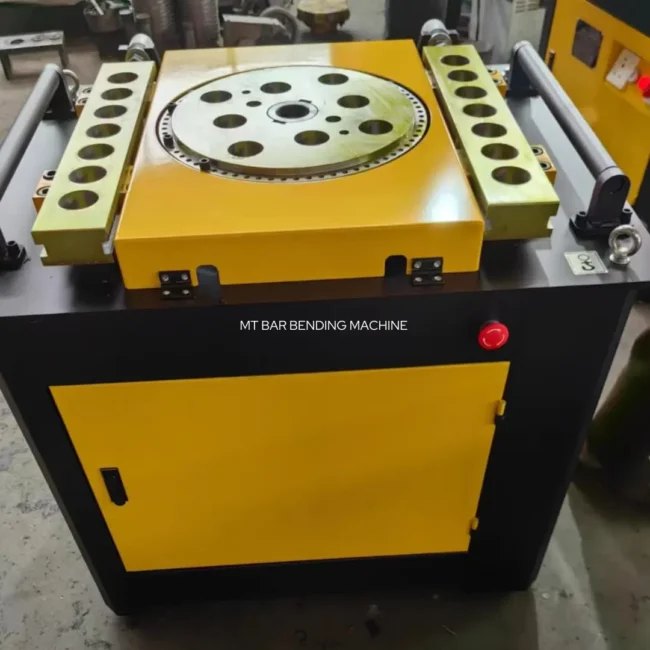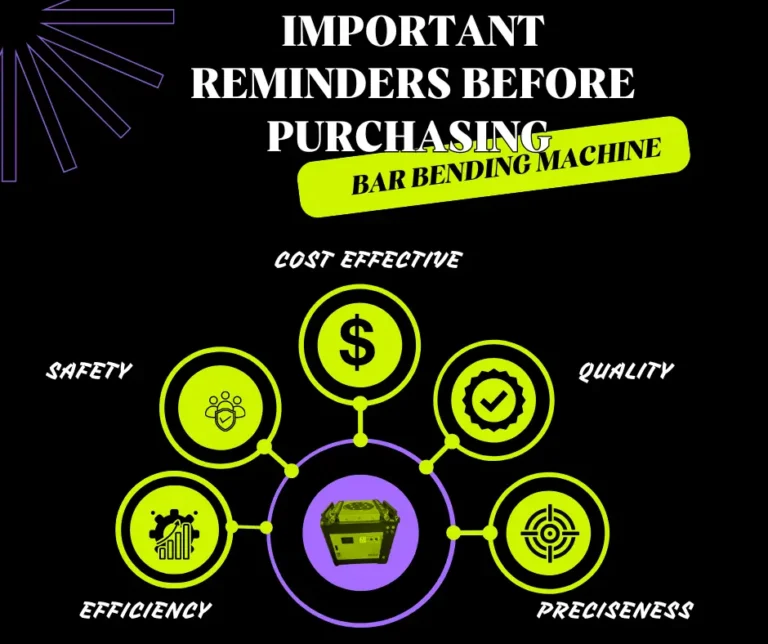Before you know how to use a rebar bending machine, you will have to know what a TMT Bar Bending Machine is.
What is a Rebar Bending Machine?
A Rebar bending machine is used to bend different types of TMT bars accurately and efficiently. It is widely used in construction projects. It’s superior strength and durability make it widely popular among civil engineers.These machines come in various sizes and capacities, depending on the thickness and length of the steel bars they are designed to bend.


BAR BENDING MACHINE — FRONT SIDE
BAR BENDING MACHINE — BACK SIDE
What points should be in your mind before using the rebar bending machine?

- Preciseness
- Efficiency
- Safety
- Quality
- Cost-effectiveness
These essential pointers are to be jotted down by the civil engineers before making any purchases.
Now, Let's Discuss How To Use A Rebar Bending Machine!!
Curious about the detailed knowledge for operating it.
Let’s begin
A TMT bar bending machine combines different components to make it use effortlessly.
- Frame: It is like the skeleton that supports the body of the machine, housing all its vital components within its framework. It needs to be sturdy and durable to withstand the forces involved in bending rebar.
- Main switch: The main switch of a bar bending machine serves as the primary control for powering the equipment on or off.
- Operating buttons: The operating buttons of a rebar bending machine include start, stop, emergency stop, direction control, speed control, angle adjustment, and reset buttons. Positioned on a control panel, they enable precise and safe control over bending operations, ensuring efficient and accurate bending of reinforcement bars.
- Bending plate: The circular disc on the rebar bending machine features holes around its circumference, each representing a specific angle. Operators can set the bending angle either by adjusting a dial or inserting a pin into the corresponding hole. This ensures precise and customizable bending according to project requirements.
- Bending roller: These are the components that apply pressure to the rebar to bend it to the desired angle or shape. They can be adjustable to accommodate different bending requirements.
- Motor: The motor provides the power necessary to operate the bending rollers and other moving parts of the machine. It can be electrically or hydraulically powered, depending on the design of the machine.
- Control panel: Many modern rebar bending machines come equipped with a control panel or interface where operators can input bending angles, lengths, and other parameters. It meticulously controls the bending process.
- Foot paddles: Some rebar bending machines are equipped with a foot pedal or hand control mechanism that allows operators to activate the bending process safely and conveniently.
These are the primary parts of a rebar bending machine, though the specific design and features can vary depending on the manufacturer and model.
Let’s Dive into how to operate a rebar bending machine
- Preparation
- Ensure that you’re wearing appropriate safety gear such as gloves, goggles, and closed-toe shoes.
- Make sure the machine is properly set up and secured to the ground.
- Check that the bending dies are correctly installed and aligned.
- Material Preparation
- Prepare the bars or rods that need to be bent according to the specifications required.
- Ensure that the bars are clean and free from any debris or rust.
- Machine Setup
- Adjust the settings on the machine according to the dimensions and angles needed for bending.
- Ensure that the bending rollers are set to the correct diameter for the bars being used.
- Loading the Material:
- Place the bar into the machine, ensuring it is aligned properly with the bending rollers.
- Adjust any guides or stops to ensure the material is positioned correctly for bending.
- Bending Process:
- Start the bending process according to the machine’s instructions. This may involve pressing a pedal, activating a lever, or using a control panel.
- Slowly feed the material through the bending rollers, applying consistent pressure to achieve the desired bend.
- Monitor the bending process carefully to ensure that the material is bending smoothly and evenly.
- If necessary, make adjustments to the machine settings or the position of the material to achieve the desired bend angle.
- Unloading:
- Once the bending process is complete, carefully remove the bent material from the machine.
- Inspect the bend to ensure it meets the required specifications.
- Safety Precautions:
- Always follow safety guidelines and procedures when operating the machine.
- Never operate the machine if you’re fatigued or distracted.
- Always keep hands and clothing away from moving parts of machines during operation.
- Be aware of pinch points and other hazards associated with the machine.
- Maintenance:
- Keep your eagle eye on the machine for signs of wear or damage.
- Keep the machine clean and lubricated according to the manufacturer’s recommendations.
- Damaged parts should be replaced immediately to ensure safe and efficient operation.
Always refer to the specific operating instructions provided by the manufacturer of your bar bending machine for detailed guidance on its operation and maintenance.
Conclusion
In conclusion, operating a rebar bending machine requires meticulous attention to detail and adherence to safety protocols. Before use, ensure proper preparation, including wearing appropriate safety gear and securing the machine. Material preparation and machine setup are crucial for achieving accurate bends. During the bending process, monitor closely for smooth and even bending, making adjustments as needed. Unloading and inspecting the bent material are the final steps, followed by regular maintenance to ensure continued safe and efficient operation. By following these steps and respecting safety guidelines, operators can harness the full potential of a rebar bending machine in construction projects.
